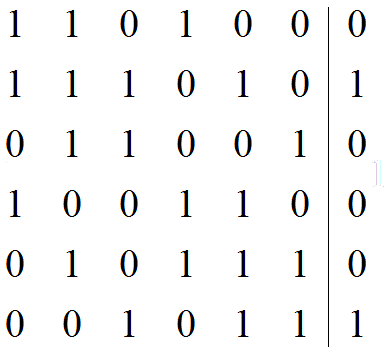POJ1222 TOJ2005 Extended Lights Out 高斯消元
描述
In an extended version of the game Lights Out?, is a puzzle with 5 rows of 6 buttons each (the actual puzzle has 5 rows of 5 buttons each). Each button has a light. When a button is pressed, that button and each of its (up to four) neighbors above, below, right and left, has the state of its light reversed. (If on, the light is turned off; if off, the light is turned on.) Buttons in the corners change the state of 3 buttons; buttons on an edge change the state of 4 buttons and other buttons change the state of 5. For example, if the buttons marked X on the left below were to be pressed, the display would change to the image on the right.

The aim of the game is, starting from any initial set of lights on in the display, to press buttons to get the display to a state where all lights are off. When adjacent buttons are pressed, the action of one button can undo the effect of another. For instance, in the display below, pressing buttons marked X in the left display results in the right display. Note that the buttons in row 2 column 3 and row 2 column 5 both change the state of the button in row 2 column 4, so that, in the end, its state is unchanged.

Note:
- It does not matter what order the buttons are pressed.
- If a button is pressed a second time, it exactly cancels the effect of the first press, so no button ever need be pressed more than once.
- As illustrated in the second diagram, all the lights in the first row may be turned off, by pressing the corresponding buttons in the second row. By repeating this process in each row, all the lights in the first four rows may be turned out. Similarly, by pressing buttons in columns 2, 3 ..., all lights in the first 5 columns may be turned off.
Write a program to solve the puzzle.
輸入
The first line of the input is a positive integer n which is the number of puzzles that follow. Each puzzle will be five lines, each of which has six 0's or 1's separated by one or more spaces. A 0 indicates that the light is off, while a 1 indicates that the light is on initially.
輸出
For each puzzle, the output consists of a line with the string: "PUZZLE #m", where m is the index of the puzzle in the input. Following that line, is a puzzle-like display (in the same format as the input) . In this case, 1's indicate buttons that must be pressed to solve the puzzle, while 0's indicate buttons, which are not pressed. There should be exactly one space between each 0 or 1 in the output puzzle-like display.
樣例輸入
2
0 1 1 0 1 0
1 0 0 1 1 1
0 0 1 0 0 1
1 0 0 1 0 1
0 1 1 1 0 0
0 0 1 0 1 0
1 0 1 0 1 1
0 0 1 0 1 1
1 0 1 1 0 0
0 1 0 1 0 0
樣例輸出
PUZZLE #1
1 0 1 0 0 1
1 1 0 1 0 1
0 0 1 0 1 1
1 0 0 1 0 0
0 1 0 0 0 0
PUZZLE #2
1 0 0 1 1 1
1 1 0 0 0 0
0 0 0 1 0 0
1 1 0 1 0 1
1 0 1 1 0 1
摘抄自:https://www.cnblogs.com/titicia/p/5396997.html
題意:給出一個5*6的圖,每個燈泡有一個初始狀態,1表示亮,0表示滅。每對一個燈泡操作時,會影響周圍的燈泡改變亮滅,問如何操作可以使得所有燈泡都關掉。
思路:因為每盞燈,如果操作兩次就相當於沒有操作,所以相當於(操作次數)%2,即異或操作。
考慮一個2*3的圖,最後需要的狀態是 : ,如果初始狀態為:
,如果初始狀態為: 。對這兩個矩陣的每個數字做異或操作可以得到線性方程組每個方程的答案。
。對這兩個矩陣的每個數字做異或操作可以得到線性方程組每個方程的答案。
總共6盞燈,0-5。那麼可以列出6個方程。
對於第0盞燈,會影響到它的是第0, 1, 3盞燈,因此可以列出方程1*x0 + 1*x1 + 0*x2 + 1*x3 + 0*x4 + 0*x5= 0。
對於第1盞燈,會影響到它的是第0, 1, 2,4盞燈,因此可以列出方程1*x0 + 1*x1 + 1*x2 + 0*x3 + 1*x4 + 0*x5 = 1。
對於第2盞燈,會影響到它的是第1, 2, 5盞燈,因此可以列出方程0*x0 + 1*x1 + 1*x2 + 0*x3 + 0*x4 + 1*x5 = 0。
.....
所以最後可以列出增廣矩陣:
然後用高斯消元求這個矩陣的解就可以了。
PS:TOJ要行末有空格才行,沒有的話反而會PE。
#include<stdio.h>
#include<algorithm>
#include<iostream>
#include<string.h>
#include<math.h>
using namespace std;
#define ll long long
const int MAXN=500;
int a[MAXN][MAXN];//增廣矩陣
int x[MAXN];//解集
void init()
{//每盞燈影響了身邊的燈
int i,j;
for(i=0;i<5;i++)
{
for(j=0;j<6;j++)
{
int pos=i*6+j;
a[pos][pos]=1;
if(i>0) a[pos][(i-1)*6+j]=1;
if(i<4) a[pos][(i+1)*6+j]=1;
if(j>0) a[pos][i*6+j-1]=1;
if(j<5) a[pos][i*6+j+1]=1;
}
}
}
void Gauss(int equ,int var)
{
int i,j,k,max_r;// 當前這列絕對值最大的行.
int col;//當前處理的列
col=0;
for(k=0;k<equ&&col<var;k++,col++)
{
max_r=k;
for(i=k+1;i<equ;i++)
{
if(abs(a[i][col])>abs(a[max_r][col]))
max_r=i;
}
if(max_r!=k)
{
for(j=k;j<var+1;j++)
swap(a[k][j],a[max_r][j]);
}
if(a[k][col]==0)
{
k--;
continue;
}
for(i=k+1;i<equ;i++)
{
if(a[i][col]!=0)
{
for(j=col;j<var+1;j++)
{
a[i][j]^=a[k][j];
}
}
}
}
for(i=var-1;i>=0;i--)
{
x[i]=a[i][var];
for(j=i+1;j<var;j++)
{
x[i]^=(a[i][j]&&x[j]);
}
}
}
int main()
{
int i,j,equ,var,mod,n,t,op=1;
scanf("%d",&t);
equ=30;var=30;
while(t--)
{
memset(a,0,sizeof(a));
init();
for(i=0;i<5;i++)
{
for(j=0;j<6;j++)
{
scanf("%d",&a[i*6+j][30]);
}
}
Gauss(equ,var);
printf("PUZZLE #%d\n",op++);
for(i=0;i<5;i++)
{
for(j=0;j<6;j++)
{
printf("%d ",x[i*6+j]);
/*if(j==0)
printf("%d",x[i*6+j]);
else
printf(" %d",x[i*6+j]);*/
}
printf("\n");
}
}
return 0;
}
